序列化流與反序列化流,列印流,工具類commons-IO
1序列化流與反序列化流
用於從流中讀取物件的操作流 ObjectInputStream 稱為 反序列化流
用於向流中寫入物件的操作流 ObjectOutputStream 稱為 序列化流
特點:用於操作物件。可以將物件寫入到檔案中,也可以從檔案中讀取物件。
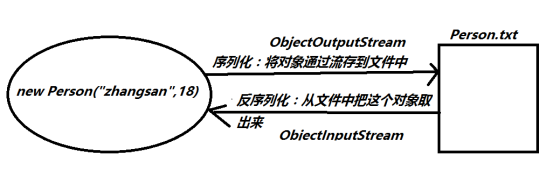
1.1物件序列化流ObjectOutputStream

例:
import java.io.Serializable;
public class Person implements Serializable{
private String name;
private int age;
public Person() {
super();
}
public Person(String name, int age) {
super();
this.name = name;
this.age = age;
}
public String getName() {
return name;
}
public void setName(String name) {
this.name = name;
}
public int getAge() {
return age;
}
public void setAge(int age) {
this.age = age;
}
@Override
public String toString() {
return "Person [name=" + name + ", age=" + age + "]";
}
}
import java.io.FileOutputStream;
import java.io.IOException;
import java.io.ObjectOutputStream;
public class Test {
public static void main(String[] args) throws IOException, ClassNotFoundException {
method01();
}
// 序列化
public static void method01() throws IOException {
Person p = new Person("zhangsan", 18);
// 明確目的地
FileOutputStream fos = new FileOutputStream("E:\\zyx\\java\\Person.txt");
// 建立序列化流
ObjectOutputStream oos = new ObjectOutputStream(fos); // 會自動關閉fos
// 向檔案中寫入物件
oos.writeObject(p);
oos.close();
}
}

1.2序列化介面
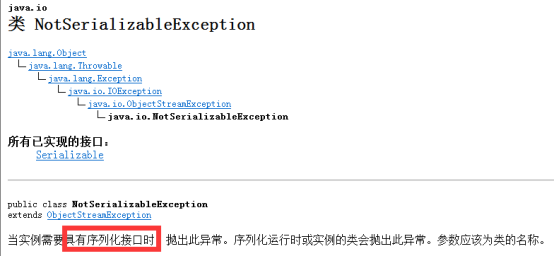
如果類都可以序列化,不安全。所以必須實現介面,才允許序列化:

標記型介面,沒有方法,不用重寫,沒有實際意義。
加上後再執行:

1.3對象反序列化流ObjectInputStream
例:
import java.io.FileInputStream;
import java.io.FileOutputStream;
import java.io.IOException;
import java.io.ObjectInputStream;
import java.io.ObjectOutputStream;
public class Test {
public static void main(String[] args) throws IOException, ClassNotFoundException {
method02();
}
// 序列化
public static void method01() throws IOException {
Person p = new Person("zhangsan", 18);
// 明確目的地
FileOutputStream fos = new FileOutputStream("E:\\zyx\\java\\Person.txt");
// 建立序列化流
ObjectOutputStream oos = new ObjectOutputStream(fos); // 會自動關閉fos
// 向檔案中寫入物件
oos.writeObject(p);
oos.close();
}
// 反序列化
public static void method02() throws ClassNotFoundException, IOException {
// 明確資料來源
FileInputStream fis = new FileInputStream("E:\\zyx\\java\\Person.txt");
// 建立反序列化流
ObjectInputStream ois = new ObjectInputStream(fis);
Object obj = ois.readObject();
Person p = (Person) obj; // 強轉
System.out.println(p);
ois.close();
}
}

說明:
1)readObject();返回值型別是Object
所以用Object接收,再強轉
2)ClassNotFoundException這個異常
如果bin中的Person.class丟失,那麼就會報這個異常

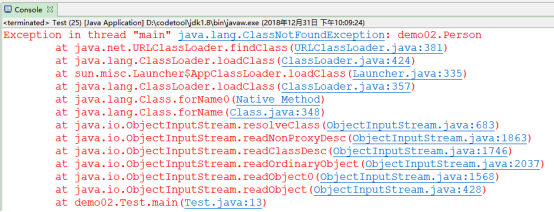
如果把age加上static

執行method01(),再執行method02(),

這說明序列化和反序列化的只是物件,靜態後的屬性因為不屬於物件了,所以不會被序列化。
還可以加上瞬態關鍵字transient
1.4瞬態關鍵字transient

執行method01(),再執行method02(),

1.5序列版本號
把Person任意改一下,直接反序列化:

結果為:序列化衝突異常

圖說明:
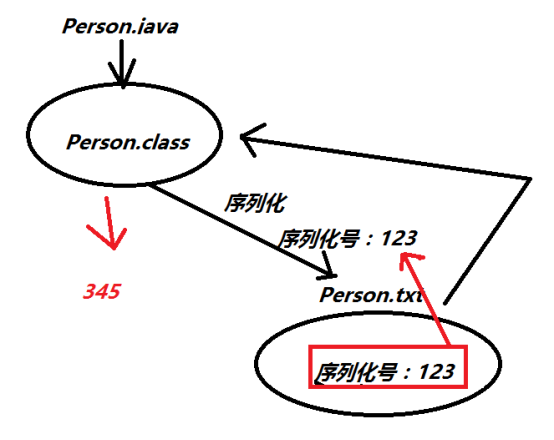
所以序列化後不要再改動Person了。
解決辦法:給Person加一個序列化號:(可以直接點出來)


這個long值可以任意改,
加上後,再序列化,然後修改Person,再反序列化,就不會報異常了。
2列印流
只是輸出流
根據流的分類:
位元組列印流 PrintStream
字元列印流 PrintWriter
方法:
void print(String str): 輸出任意型別的資料,
void println(String str): 輸出任意型別的資料,自動寫入換行操作
可以用write方法,但是走碼錶,而這兩個是原樣輸出
2.1PrintStream
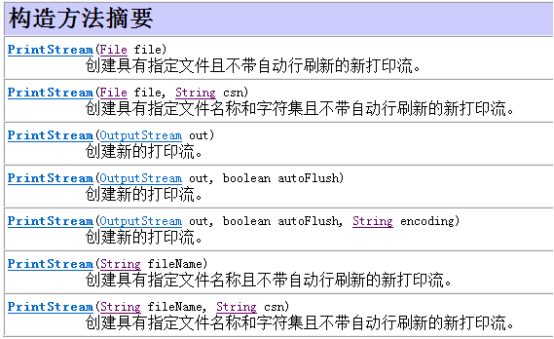
例:
import java.io.IOException;
import java.io.PrintStream;
public class Test {
public static void main(String[] args) throws IOException, ClassNotFoundException {
PrintStream ps=new PrintStream("E:\\zyx\\java\\print.txt");
ps.print(100);
ps.println("你好");
ps.println("換行");
ps.write(100);
ps.close();
}
}
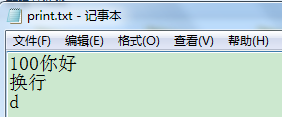
說明:
print()原樣輸出
println()可以換行
write()走碼錶
2.2續寫
傳一個FileOutputStream物件:
import java.io.FileOutputStream;
import java.io.IOException;
import java.io.PrintStream;
public class Test {
public static void main(String[] args) throws IOException, ClassNotFoundException {
FileOutputStream fos=new FileOutputStream("E:\\zyx\\java\\print.txt",true);
PrintStream ps=new PrintStream(fos);
ps.print(100);
ps.println("你好");
ps.println("換行");
ps.write(100);
ps.close();
}
}

2.3 PrintWriter
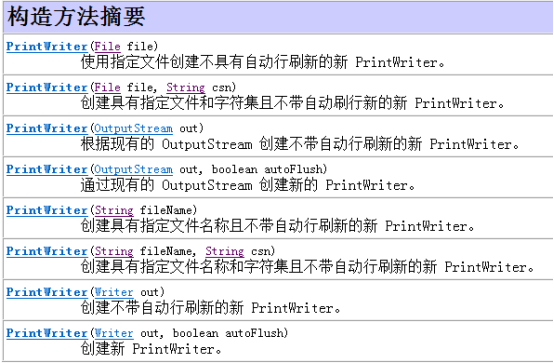
例:
import java.io.IOException;
import java.io.PrintWriter;
public class Test {
public static void main(String[] args) throws IOException, ClassNotFoundException {
PrintWriter pw=new PrintWriter("E:\\zyx\\java\\print.txt");
pw.println("你好");
pw.println("java");
pw.flush();
pw.close();
}
}
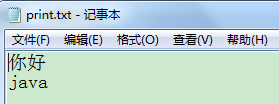
2.4自動重新整理
import java.io.FileOutputStream;
import java.io.IOException;
import java.io.PrintWriter;
public class Test {
public static void main(String[] args) throws IOException, ClassNotFoundException {
// 位元組輸出流明確目的地
FileOutputStream fos = new FileOutputStream("E:\\zyx\\java\\print.txt");
// 建立自動重新整理的字元列印流
PrintWriter pw = new PrintWriter(fos, true);
pw.println("你好");
pw.println("java");
pw.close();
}
}
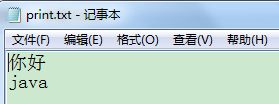
2.5複製
import java.io.BufferedReader;
import java.io.FileReader;
import java.io.FileWriter;
import java.io.IOException;
import java.io.PrintWriter;
public class CopyTest {
public static void main(String[] args) throws IOException {
copy();
}
public static void copy() throws IOException{
//明確資料來源
FileReader fr=new FileReader("E:\\zyx\\java\\print.txt");
BufferedReader br=new BufferedReader(fr);
//明確目的地
FileWriter fw=new FileWriter("E:\\zyx\\java\\a\\print.txt");
PrintWriter pw=new PrintWriter(fw,true); //自動重新整理
String line="";
while((line=br.readLine())!=null){
pw.println(line);
}
br.close();
pw.close();
}
}

用列印流複製不用重新整理和換行了
列印流總結:
1)只有輸出目的地
2)不會拋IO異常
3 工具類commons-IO
3.1匯入classpath
加入classpath的第三方jar包內的class檔案才能在專案中使用

建立lib資料夾
將commons-io.jar拷貝到lib資料夾
右鍵點選commons-io.jar,Build Path→Add to Build Path
3.2 FilenameUtils
用來處理檔名的,可以輕鬆解決不同作業系統檔名稱規範不同的問題
常用方法:
1)getExtension(String path):獲取檔案的副檔名;
2)getName(String filename):獲取檔名;
3)isExtension(String fileName,String ext):判斷fileName是否是ext字尾名;
例:
import java.io.IOException;
import org.apache.commons.io.FilenameUtils;
public class Test {
public static void main(String[] args) throws IOException, ClassNotFoundException {
// 獲取副檔名
String ext = FilenameUtils.getExtension("E:\\zyx\\java\\demo.txt");
System.out.println(ext);
// 獲取檔名
String filename = FilenameUtils.getName("E:\\zyx\\java\\demo.txt");
System.out.println(filename);
// 判斷是否是java檔案
boolean flag = FilenameUtils.isExtension("E:\\zyx\\java\\demo.txt", "java");
System.out.println(flag);
}
}

3.3 FileUtils
常用方法:
1)readFileToString(File file):讀取檔案內容,並返回一個String;
import java.io.File;
import java.io.IOException;
import org.apache.commons.io.FileUtils;
public class Test {
public static void main(String[] args) throws IOException, ClassNotFoundException {
File file=new File("E:\\zyx\\java\\print.txt");
String content=FileUtils.readFileToString(file);
System.out.println(content);
}
}

2)writeStringToFile(File file,String content):將內容content寫入到file中;
import java.io.File;
import java.io.IOException;
import org.apache.commons.io.FileUtils;
public class Test {
public static void main(String[] args) throws IOException, ClassNotFoundException {
File file=new File("E:\\zyx\\java\\print.txt");
FileUtils.writeStringToFile(file, "你好");
}
}

3)copyDirectoryToDirectory(File srcDir,File destDir); 資料夾複製
import java.io.File;
import java.io.IOException;
import org.apache.commons.io.FileUtils;
public class Test {
public static void main(String[] args) throws IOException, ClassNotFoundException {
// 資料來源
File file = new File("E:\\zyx\\java\\b");
// 目的地
File file2 = new File("E:\\zyx\\java\\e");
// 複製
FileUtils.copyDirectoryToDirectory(file, file2);
}
}


4)copyFile(File srcFile,File destFile); 檔案複製
import java.io.File;
import java.io.IOException;
import org.apache.commons.io.FileUtils;
public class Test {
public static void main(String[] args) throws IOException, ClassNotFoundException {
// 資料來源
File file = new File("E:\\zyx\\java\\eclipse.zip");
// 目的地
File file2 = new File("E:\\zyx\\java\\f\\eclipse.zip");
// 複製
long start=System.currentTimeMillis();
FileUtils.copyFile(file, file2);
long end=System.currentTimeMillis();
System.out.println(end-start);
}
}


練習:用常規方法複製資料夾(及檔案)
